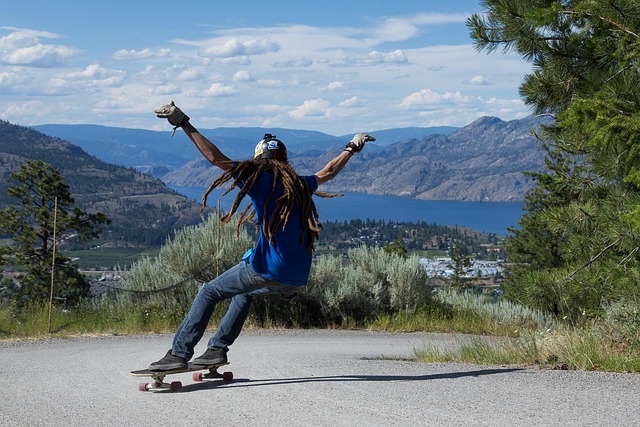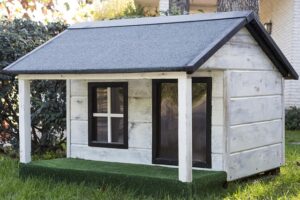Downhill longboarding is an exhilarating sport for beginners, focusing on specialized boards with drop-down platforms for control. Opt for wider decks made from durable materials like maple or fiberglass, with large (70mm+) wheels for stability and speed. Choose trucks offering responsive turning and soft bushings for a smoother ride as skills improve. These setups enable beginners to navigate steep slopes safely, building confidence through practice on gentle terrain before tackling challenges.
Looking to conquer downhill trails on your first longboard ride? This comprehensive guide is tailored for aspiring riders, offering insights into the thrilling world of downhill longboarding. We demystify the sport, providing essential tips on choosing the perfect board and understanding its key features. From setting up your gear to mastering tricks, we’ve compiled a roadmap for beginners seeking to conquer slopes with confidence. Discover the benefits of longboards, explore top recommendations, and get ready to roll into an exhilarating new adventure!
Understanding Downhill Riding and Its Appeal

Downhill riding is a thrilling and unique form of longboard riding that has gained immense popularity among enthusiasts worldwide. It involves speed, precision, and an adrenaline rush as riders navigate steep slopes and challenging terrain. This extreme sport offers a different experience compared to cruising or carving on a longboard, attracting those seeking an exciting adventure.
For beginners exploring the world of downhill riding, it’s essential to grasp the basics. A longboard designed specifically for this discipline is ideal, offering better control and stability at high speeds. These boards often have drop-down platforms for a lower center of gravity, enhancing maneuverability. Understanding the appeal lies in conquering fears, mastering techniques, and experiencing the freedom and thrill of gliding downhill with precision.
Choosing the Right Longboard for Your First Ride

When selecting your first longboard, choosing one suitable for downhill riding is a great starting point. As a beginner, look for boards designed with stability and speed in mind. Deck shapes should be wider and longer to provide better balance at higher speeds. Consider decks made from 7-layer maple or fiberglass composite materials for strength and durability. These boards often come with drop-down or drop-through deck designs, which lower your center of gravity, making it easier to control and maneuver.
Additionally, pay attention to wheel size and durometer (hardness). Larger wheels (70mm+), designed for cruising, offer a smoother ride but may not be as agile. Smaller 58-65mm wheels provide better turn responsiveness but are more sensitive to road irregularities. A durometer between 75-90a is ideal for downhill riding, offering a balance between speed and shock absorption. Always ensure the longboard has robust trucks and bearings to withstand the forces of downhill riding.
Key Features to Look For in a Beginner-Friendly Downhill Longboard

When looking for a downhill longboard suitable for beginners, there are several key features to consider. Firstly, stability is paramount. A board with a wider stance and a longer deck provides better balance, reducing the risk of crashes, especially at higher speeds. Additionally, look for smooth and responsive trucks. These allow for easier turning and control, enabling beginners to navigate slopes and curves with confidence.
Another crucial aspect is durability. Beginners may be less experienced with controlling their speed and carving turns precisely, so a board built from high-quality materials like maple or bamboo will withstand the potential rough handling. Furthermore, soft bushings in the trucks offer a smoother ride and make it easier to adjust to different terrain conditions as your skills develop.
Benefits of Longboards for Downhill Beginners

For downhill riding enthusiasts, especially beginners, opting for a longboard can be an excellent decision. These boards offer a smooth and stable platform, making them ideal for navigating steep slopes and rough terrains. The benefits are manifold; longboards provide better control and balance, allowing riders to focus on mastering the art of downhill riding without worrying about instability.
They are designed with larger wheels, which absorb shocks effectively, ensuring a comfortable ride. This feature is particularly advantageous for beginners who might be nervous about handling high speeds and unpredictable paths. Moreover, longboards typically have a more relaxed deck shape, promoting a comfortable stance and reducing fatigue during extended rides, making them the perfect choice for those new to downhill riding.
Top 5 Recommended Longboards for Downhill Newbies

For downhill newcomers looking to carve their way down hills with confidence, choosing the right longboard is a must. Here’s a list of our top picks for beginners navigating the world of downhill riding:
1. Landyachtz Drop Carve: This board offers an excellent balance between stability and maneuverability, making it ideal for first-timers. Its drop-down platform provides a comfortable riding position while allowing for easy carving. The Landyachtz Drop Carve is built with durability in mind, featuring high-quality materials that ensure longevity even after numerous runs.
2. Rayne Tactix: Designed to cater to both beginners and seasoned riders, the Rayne Tactix excels on various terrain types. Its versatile design enables smooth transitions from cruising to carving. With a responsive deck and robust construction, this longboard provides stability at high speeds, making it a great choice for downhill newcomers looking to build confidence.
3. Gilligantus Goliath: The Gilligantus Goliath is a beast on wheels, offering exceptional speed and control. Its extra-long deck provides ample space for a comfortable stance, while its drop-through design keeps the rider low to the ground for improved stability. Perfect for those who want to conquer steeper slopes with ease.
4. Loaded Tan Tien: Known for its versatility, the Loaded Tan Tien is an excellent choice for downhill newbies exploring different riding styles. Its unique shape and drop platform allow for a wide range of maneuvers, from cruising to carving and dancing. The Tan Tien’s durable construction ensures it can withstand the challenges of downhill riding.
5. Rayne Phoenix: Lightweight yet sturdy, the Rayne Phoenix is designed with beginners in mind. It glides effortlessly, making it easy for newcomers to maintain control at various speeds. Its drop-down design and flexible deck provide a smooth ride, allowing riders to focus on perfecting their technique without worrying about stability.
Setting Up Your Downhill Longboard: A Step-by-Step Guide

Setting up your downhill longboard is an exciting step for any beginner looking to conquer steep slopes and thrilling descents. Here’s a simple, step-by-step guide to ensure your board is ready for action.
Start by selecting a board designed specifically for downhill riding, considering factors like deck shape, wheel size, and truck positioning. For beginners, opt for a more stable design with larger wheels (typically 70mm or bigger) for better control on various terrains. Mount the trucks securely, ensuring they are aligned and tightened according to the manufacturer’s instructions. Next, install the wheels, considering a set that offers a balance between speed and maneuverability. Check the pressure regularly, as suitable inflation enhances performance and safety. Don’t forget to add padding and protective gear, especially elbow and knee pads, for added security during rides.
Tips and Tricks for a Successful Downhill Riding Experience

Downhill riding can be an exhilarating experience, especially on a longboard designed for beginners. Here are some tips to ensure your first attempt is both fun and safe. Start by choosing the right board; look for a stable, wide deck that offers better control at high speeds. Always wear protective gear, including a helmet, knee pads, and elbow pads, as falls can be intense.
Practice makes perfect! Begin on gentle slopes to get a feel for your longboard’s handling. Learn how to pump and carve turns, techniques crucial for controlling speed and navigating twists. Remember, downhill riding is about understanding gravity; use it to your advantage while staying alert for potential hazards like rocks or loose debris.
